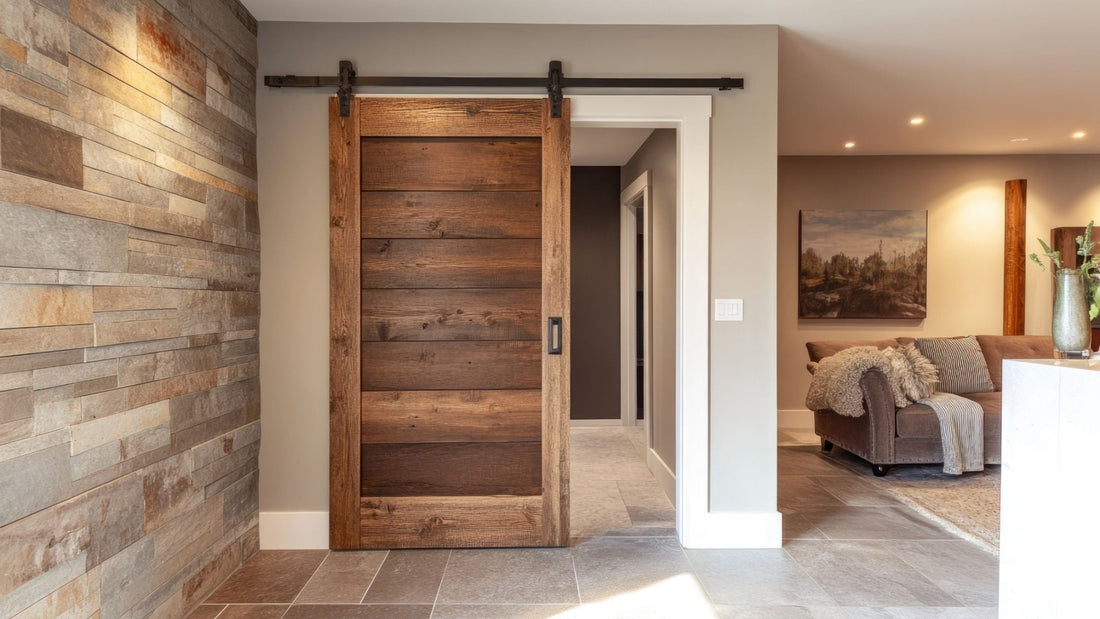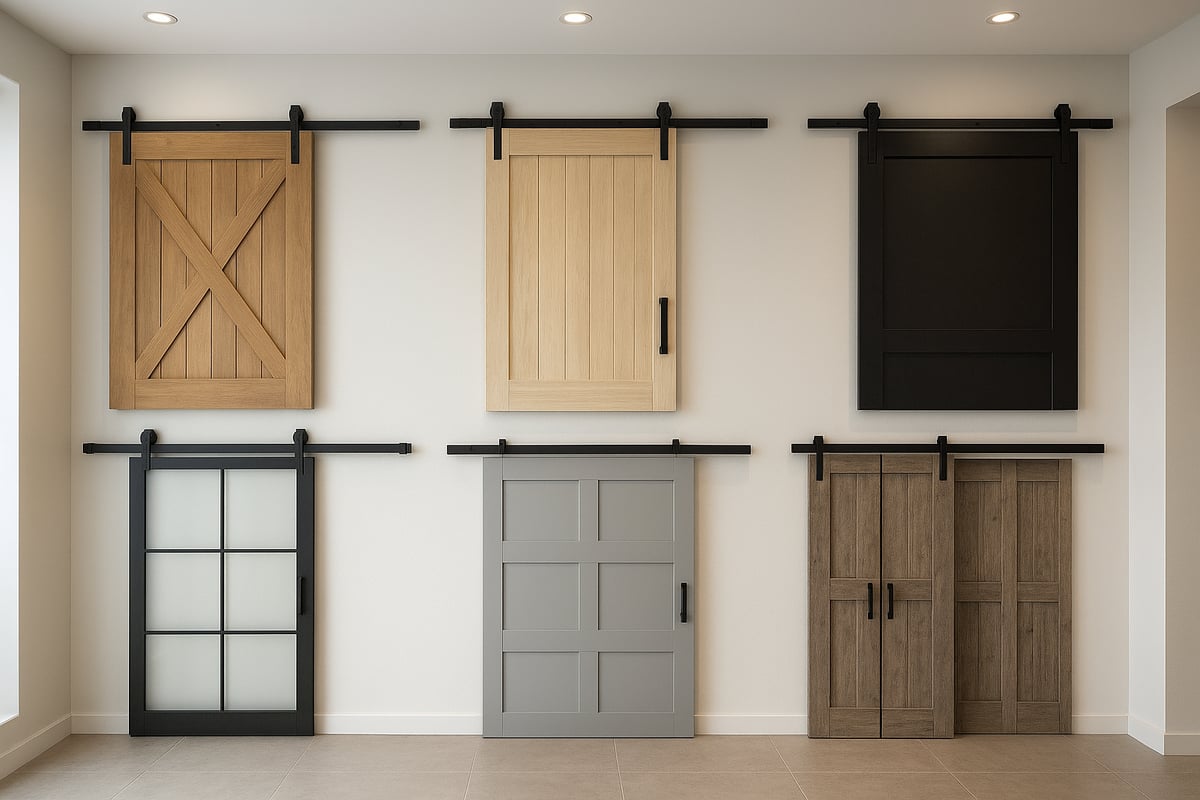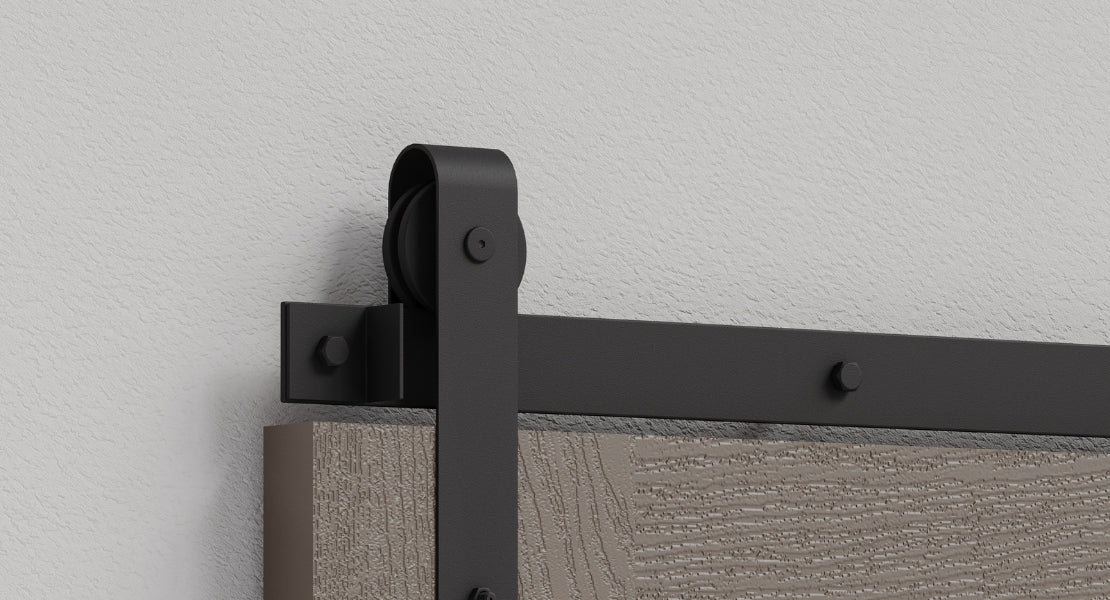
The Barn Doors Guide: Your Essential Handbook for 2025
Curious why the barn doors are making such a splash in 2025 home design? These doors blend rustic charm with sleek, modern function, making them a favorite for both new builds and renovations.
This essential handbook is here to guide you through every aspect of barn doors, whether you're a homeowner, a designer, or a hands-on DIYer.
You'll discover everything from the history and types to the best materials, hardware choices, installation steps, styling tips, and maintenance essentials. Ready to create a stylish upgrade? Dive in for expert advice and inspiration.
The Evolution of Barn Doors: From Farmhouse to Modern Homes
Ever wondered how the barn doors made their way from humble farms to the heart of modern homes? Their story is as rich as the wood they’re often crafted from. Let’s journey through time and style, and discover what makes the barn doors such a favorite in both classic and contemporary spaces.

Historical Origins and Traditional Uses
The barn doors began as practical solutions in agricultural settings. Farmers needed a way to protect livestock and equipment while allowing for wide, easy-to-move openings. Heavy wood planks, sturdy joinery, and simple iron hardware defined these doors in 19th-century American barns.
Back then, the barn doors were about function over form. Their sliding mechanism minimized space requirements, letting you move large items in and out without fuss. This basic design soon became iconic, symbolizing rural ingenuity and craftsmanship.
Rise in Residential and Commercial Design
Fast forward to today, and you’ll notice the barn doors are no longer just for barns. They’ve transitioned into urban lofts, suburban homes, and trendy commercial spaces. Their unique blend of character and adaptability caught the eye of designers and homeowners alike.
Want proof? According to Houzz, there was a 35% increase in barn door installations in homes in 2023. Curious about the range? The Barn Door Collection Overview showcases just how many styles and finishes are now available, making it easy to find one that fits your space.
Key Benefits Driving Modern Adoption
Why are the barn doors gaining so much traction? Their space-saving design is a game changer, especially in smaller homes or rooms where a traditional swinging door just won’t do. They also offer unbeatable versatility, acting as a stylish room divider, a closet door, or a unique pantry entrance.
Some key benefits of the barn doors include:
- Saving valuable floor space
- Providing flexible room separation
- Enhancing privacy without sacrificing style
From bathrooms to pantries, the barn doors bring both function and flair to any setting.
Influence of Interior Design Trends
Interior designers are constantly on the lookout for adaptable, visually striking elements, and the barn doors fit the bill. They mesh seamlessly with rustic, industrial, and even minimalist aesthetics. Customization is a big driver too, with painted, stained, or distressed finishes fueling the demand.
Did you know? A recent ASID report found that 52% of designers recommend the barn doors for flexible layouts. They offer endless possibilities, letting you tailor your home to your personality and needs.
Notable Projects and Inspirations
The barn doors have become a staple on popular home improvement shows and social media feeds. High-profile renovations often feature them as statement pieces, whether in cozy cottages or sleek urban condos. Instagram and Pinterest are packed with creative barn door ideas, inspiring homeowners to think outside the box.
You’ll even spot the barn doors in commercial settings like boutique shops and cafes, proving their versatility and timeless appeal. From farmhouse roots to modern marvels, the barn doors continue to inspire and evolve.
Types of Barn Doors and Their Ideal Applications
Choosing the right barn door can feel overwhelming, but once you know your options, it becomes an exciting design decision. Let’s break down the main types, styles, and materials so you can confidently select the barn doors that fit your space and style.

Single vs. Double Barn Doors
When planning the barn doors for your home, first decide between single and double door setups. Single barn doors are ideal for smaller spaces, such as pantries or bathrooms, where you want a compact, space-saving solution. Double barn doors, on the other hand, create a dramatic entrance and work perfectly for wide openings like dining rooms or living areas.
Single doors are easier to install and require less wall space for the track. Double doors, however, offer symmetry and a grander feel, especially in open-concept layouts. Picture a pair of sliding doors parting to reveal a cozy den or formal dining space. Whichever you pick, the barn doors can elevate both function and style.
Sliding, Bifold, and Bypass Systems
The barn doors come in several operational styles, each suited to different needs. Sliding systems are the most popular, claiming a 65% market share, since they glide smoothly and save floor space. Bifold barn doors fold neatly to one side, making them perfect for closets or laundry rooms where you want full access.
Bypass systems let multiple doors slide past each other, great for tight hallways or covering large openings without needing much wall space. Each system offers its own pros and cons, so think about your room’s layout and how you’ll use the barn doors day-to-day.

Material Choices: Wood, Metal, Glass, and Composites
Selecting the right material is key for both aesthetics and durability. The barn doors crafted from solid wood like pine, oak, or reclaimed timber bring warmth and a classic touch to interiors. Metal doors, with their sleek lines and sturdy feel, fit right in with industrial or modern spaces.
Glass barn doors, especially frosted or textured, create privacy while letting light filter through—ideal for offices or bathrooms. Composite materials offer a lightweight and budget-friendly alternative, often mimicking the look of real wood or metal. Consider your lifestyle and maintenance preferences when choosing materials for the barn doors.
Style Variations: Rustic, Modern, Industrial, and Custom Designs
There’s no shortage of style options for the barn doors, whether you love rustic charm, sleek modern lines, or edgy industrial vibes. Rustic barn doors typically feature distressed wood, visible knots, and traditional cross-bracing. Modern styles lean toward clean lines, bold colors, and minimalist hardware.
Industrial designs use raw materials like steel, matte black hardware, and exposed bolts. Customization is huge right now—painted, stained, or even patterned finishes let you make the barn doors truly yours. Don’t be afraid to mix and match finishes for a unique statement.
Sizing and Configuration Options
Standard sizes work for most homes, but sometimes you need the barn doors tailored for unique or oversized openings. Single, double, bypass, and even multi-panel configurations are available, giving you flexibility for any space. For non-standard doorways or creative projects like room dividers, custom sizing is the way to go.
If you’re unsure where to start, you can explore the Custom Barn Door Quote Process, which helps you get personalized solutions for your project. Getting the barn doors sized just right ensures smooth operation and a professional look.
Cost Considerations by Type and Material
Budgeting for the barn doors means weighing type, material, and customization. Here’s a quick cost breakdown:
| Type/Material | Average Price Range |
|---|---|
| Standard Wood | $300 - $700 |
| Custom Wood | $600 - $1,200 |
| Metal | $500 - $1,000 |
| Glass | $700 - $1,500 |
| Composite | $250 - $600 |
Custom doors can run 30% to 50% more than standard options. Hardware, finishes, and installation may add to your total. Knowing these ranges helps you plan for the barn doors that fit both your vision and your budget.
Environmental and Sustainability Factors
Eco-friendly design is more important than ever, and the barn doors can be a sustainable choice. Many manufacturers use reclaimed wood or recycled metal, reducing waste and giving new life to old materials. Low-VOC finishes and non-toxic paints protect indoor air quality, making your home healthier.
Some options even contribute to green building certifications like LEED. By choosing sustainably sourced materials, you not only get beautiful barn doors but also support a more responsible approach to home design.
Choosing the Right Barn Door Hardware
Choosing the right hardware truly makes or breaks the experience with the barn doors. Whether you’re upgrading a single space or planning a whole-home project, your hardware choices impact everything from daily usability to the final look. Let’s walk through what you need to know.
Essential Hardware Components
When you picture the barn doors, what comes to mind? Most people think of the door itself, but the hardware is just as important. The essentials include:
- Tracks (the rail the door slides on)
- Rollers (wheels attached to the door)
- Handles and pulls
- Floor guides (keep the door steady)
- Stops (prevent the door from sliding off)
Each part of the barn doors hardware plays a unique role. Without sturdy tracks or smooth rollers, even the most beautiful door can be a hassle. Always check that all required components are compatible with your specific door type and size.

Weight Capacity and Door Compatibility
Have you ever wondered if all hardware fits every door? Not quite. The barn doors can be crafted from solid wood, metal, or glass, so weight varies a lot. Standard residential hardware supports doors from 150 to 400 lbs.
Before you buy, check your door’s material and size. Oversized or solid wood designs need heavy-duty tracks and rollers. Choosing hardware with the right weight rating ensures the barn doors glide smoothly for years.
Aesthetic Impact of Hardware Selection
The hardware isn’t just about function—it’s a style statement. Imagine the barn doors with matte black tracks in a modern loft or brushed steel in an industrial space. Hardware color and finish can either blend in or pop as a focal point.
Mixing finishes, like pairing bronze handles with black tracks, adds a unique touch. The barn doors hardware sets the tone for the entire room, so take time to choose finishes that match your vision.
Installation Requirements and Space Planning
You might be surprised—most installation headaches happen from poor planning. The barn doors need enough wall space to slide open fully. You’ll also need clearance above the opening for tracks and sturdy wall studs for mounting.
Measure twice, install once. If your wall has obstructions like light switches or vents, plan around them. According to HomeAdvisor, 80 percent of issues stem from skipping this step. A little extra prep saves frustration later.
Safety and Security Features
Safety should always be top of mind, especially if you have kids or pets. The barn doors can slam if not equipped with soft-close mechanisms. Anti-jump blocks keep the door from lifting off the track, and privacy locks add functionality for bedrooms and bathrooms.
Look for hardware kits that include these features. The barn doors are as safe as the hardware you choose, so never skimp on these critical details.
Sourcing Quality Hardware: What to Look For
With so many choices out there, how do you pick the best? Start by checking durability, warranty, and customer support. Reviews from real buyers are gold. If you want a deep dive into different options, the Barn Door Hardware Kits Guide gives a side-by-side look at premium, heavy-duty, and budget kits for the barn doors.
Here’s a quick comparison:
| Feature | Premium Kits | Budget Kits |
|---|---|---|
| Material | Solid steel, brass | Aluminum, composite |
| Warranty | Lifetime | 1-2 years |
| Support | Expert guidance | Limited |
| Price | $$$ | $ |
Choosing wisely means your barn doors will function beautifully and last for years.
Step-by-Step Guide to Installing a Barn Door in 2025
Ready to transform your space? Installing the barn doors can be a rewarding DIY project if you follow the right steps. Let’s break down the process so you can confidently tackle your next installation, whether you’re a first-timer or a seasoned renovator.
Pre-Installation Planning and Measurements
Every successful project with the barn doors starts with careful planning. Begin by assessing your wall structure. Is there enough clearance above and beside the opening? Identify if you’ll need a header board, especially if you’re mounting the hardware on drywall instead of solid wood.
Next, measure the width and height of your doorway. Add a few extra inches to the width so the barn doors fully cover the opening. For bypass systems, double-check that there’s enough space for both doors to slide without obstruction. Take your time with these steps. Precise measurements are the foundation for a flawless result.
Gathering Tools and Materials
Before you dive in, gather all the tools and materials needed to install the barn doors. Here’s a quick checklist:
- Level
- Drill and drill bits
- Stud finder
- Measuring tape
- Screwdriver
- Wrench set
- Pencil for marking
- Safety gear (goggles and gloves)
Lay out your barn door, hardware kit, and any accessories. Double-check the instructions included with the barn doors, as some kits may require specialty tools or specific fasteners. Having everything ready will make the process smoother and help you avoid last-minute trips to the hardware store.
Preparing the Door and Hardware
Now, turn your attention to prepping the barn doors and hardware. If you’re painting, staining, or finishing the doors, do this before installation. Sand any rough edges for a smooth feel. Make sure the finish is dry before you proceed.
Assemble the hardware components—rollers, handles, and brackets. Pre-drill holes for handles and hardware as marked in the instructions. Organize all the screws and parts so you can quickly access them during installation. Prepping saves time and ensures the barn doors look and function at their best.
Installing the Track and Mounting Hardware
With your tools ready, it’s time to install the track for the barn doors. Use a stud finder to locate the wall studs above the doorway. If you’re working with drywall, secure a header board to the studs for added support.
Hold the track up to the wall and mark the mounting holes. Drill pilot holes into the studs or header board, then attach the track using the provided hardware. Use a level to check that the track is perfectly straight. This step is crucial for smooth sliding and long-term durability of the barn doors.
Hanging the Barn Door
It’s the moment of truth—hanging the barn doors. Attach the rollers to the top of the door, following the manufacturer’s guidelines. With help, lift the door and align the rollers with the track. Carefully set the barn doors onto the track, making sure the rollers are seated properly.
Once the doors are up, adjust the hardware as needed so the doors slide smoothly and evenly. Take a moment to admire your progress. Getting the barn doors on the track is a major milestone in your installation journey.
Final Adjustments and Safety Checks
Now, focus on safety and performance. Install floor guides to keep the barn doors stable and prevent swinging. For more details on guide options and installation, check out Floor Guides for Barn Doors.
Add anti-jump devices to ensure the doors stay securely on the track. Test the movement of the barn doors, making sure they glide quietly and align with the wall. If your setup includes soft-close mechanisms or locks, install and test those as well. Safety checks give you peace of mind and ensure lasting functionality.
Troubleshooting Common Installation Issues
Even with careful planning, you might run into a few hiccups installing the barn doors. If the doors don’t slide smoothly, check for misaligned tracks or debris in the rollers. For doors rubbing against the wall, adjust the track spacing or use spacers.
If you notice noise during operation, lubricate the rollers and track lightly. For uneven door movement, double-check your measurements and hardware tightness. Remember, each challenge with the barn doors is solvable with a little patience and attention to detail. Soon, you’ll enjoy the perfect blend of style and function in your space.
Styling and Customizing Barn Doors for Every Space
Looking to make your space stand out? The barn doors are one of the most versatile design elements you can add to your home. Whether your style leans rustic, farmhouse, modern, or industrial, these doors fit right in. You can pair the barn doors with bold hardware, soft hues, or even metallic finishes to create a look that feels uniquely yours.
Integrating Barn Doors into Different Design Schemes
You might be surprised at how easily the barn doors fit into almost any interior. For a cozy farmhouse vibe, try distressed wood and classic hardware. Prefer modern? Go for sleek lines and a glossy painted finish. Industrial spaces often benefit from metal accents or darker stains for the barn doors. Want something eclectic? Mix bold colors with unexpected hardware choices for a playful twist.
- Rustic: Weathered wood, black iron hardware
- Modern: Smooth finishes, minimalist handles
- Industrial: Steel accents, matte finishes
- Glam: White doors with gold or brass hardware
With so many options, the barn doors can truly complement your personal style.
Creative Uses Beyond Room Dividers
Think the barn doors are just for separating rooms? Think again. These doors work beautifully as closet doors, pantry entries, or even bathroom doors. In open-concept spaces, the barn doors offer privacy when needed and can be left open to create flow. Some creative homeowners use the barn doors as TV covers, headboards, or even statement wall art.
Businesses are catching on too. You might spot the barn doors in trendy cafes or boutiques, adding both function and flair. The possibilities go far beyond the standard doorway.
Personalization Options: Paint, Stain, and Hardware
Customizing the barn doors lets you showcase your creativity. Painting is a quick way to match your door to your décor, while staining brings out the natural beauty of wood. You can choose from classic whites, rich stains, or even bold colors that pop. Hardware plays a huge role in the final look, so don't be afraid to mix finishes or styles.
According to the Interior Sliding Barn Doors Market Report, there is a growing trend toward unique customization, with more homeowners opting for special finishes and decorative hardware. This means the barn doors are not only practical but also a reflection of your personal taste.
Accessorizing with Handles, Pulls, and Decorative Elements
The right accessories can elevate the barn doors from simple to stunning. Consider adding leather strap handles for a rustic touch or sleek metal pulls for a modern edge. Decorative elements like windows, mirrors, or even chalkboard panels can enhance both style and function. Try pairing distinctive handles with contrasting door finishes for a look that feels custom-made.
Adding these details ensures the barn doors are as much a design statement as they are a functional feature in your space.
Maximizing Functionality with Smart Features
Want to take the barn doors to the next level? Look for smart features like soft-close systems to prevent slamming or lockable options for privacy. Automated barn doors that connect with home automation systems are gaining popularity, making it easy to open or close doors with a tap or voice command. As technology advances, the barn doors continue to blend tradition with innovation, offering style, convenience, and flexibility in any setting.
Maintenance, Care, and Longevity Tips for Barn Doors
Keeping the barn doors in top shape is easier than you might think. With just a bit of regular attention, you can extend their beauty and function for years. Let’s walk through the essentials of caring for the barn doors, so you feel confident tackling every aspect of maintenance.
Regular Cleaning and Upkeep
Start by dusting the barn doors weekly with a soft microfiber cloth. For wood doors, use a gentle, natural wood cleaner to avoid residue buildup. If your doors are glass or metal, a damp cloth with mild soap keeps them streak free.
Don’t forget to wipe down the track and hardware, as dust and debris can affect performance. By making cleaning part of your routine, you’ll preserve the barn doors’ finish and keep them looking their best.
Preventing and Addressing Wear and Tear
Inspect the barn doors and their hardware every few months. Look for loose screws, worn rollers, or any signs of rust. Tighten hardware as needed and apply a silicone-based lubricant to moving parts to ensure smooth sliding.
Address minor dings or scratches right away. For more insight on maintaining door hardware, check out the Barn Door Hardware Market Analysis for trends and product recommendations. Proactive care helps the barn doors resist premature wear.
Seasonal Adjustments and Environmental Considerations
The barn doors can shift slightly with changes in humidity and temperature. If you notice sticking or gaps, adjust the hardware or track alignment as needed. In humid climates, use a dehumidifier to prevent wood warping.
Check for condensation on metal or glass doors, wiping it away before it causes corrosion. A little seasonal attention keeps the barn doors opening smoothly year round.
Repairing Common Issues
If the barn doors start to squeak, grind, or rub against the wall, don’t panic. Usually, a quick adjustment to the track or rollers fixes the issue. Replace damaged rollers or tracks promptly for safety.
For surface scratches or dents, touch up wood finishes with matching stain or filler. If you encounter persistent problems, consider consulting a professional to keep the barn doors in top working order.
Extending the Life of Your Barn Door Investment
Protect the barn doors with quality finishes like polyurethane or natural oils. These barriers shield against moisture and daily wear. Upgrading to premium hardware can also add years to your doors’ lifespan.
According to Residential Sliding Barn Doors Market Trends, investing in robust materials and well-designed hardware pays off in longevity. With a little care, the barn doors can last over two decades.
Sustainability and Eco-Friendly Maintenance
Choose non-toxic cleaners and water-based finishes to protect both the barn doors and your indoor air quality. If you ever replace a door, think about repurposing the old panels as wall art or shelving.
By opting for sustainable practices, you not only extend the life of the barn doors but also support a greener home. These small choices add up, benefiting both your space and the environment.
So now that you’ve got the inside scoop on barn doors—from design inspiration to installation tricks and smart style upgrades—you might be wondering where to actually find the right hardware for your next project. You should browse The Barn Door Hardware Store. You’ll find everything from sleek sliding systems to heavy duty kits, plus expert support if you ever hit a snag. We even offer free shipping across the continental US and back up our hardware with a lifetime warranty.
Ready to make your barn door vision a reality? Go check out our hardware and start planning your upgrade!


